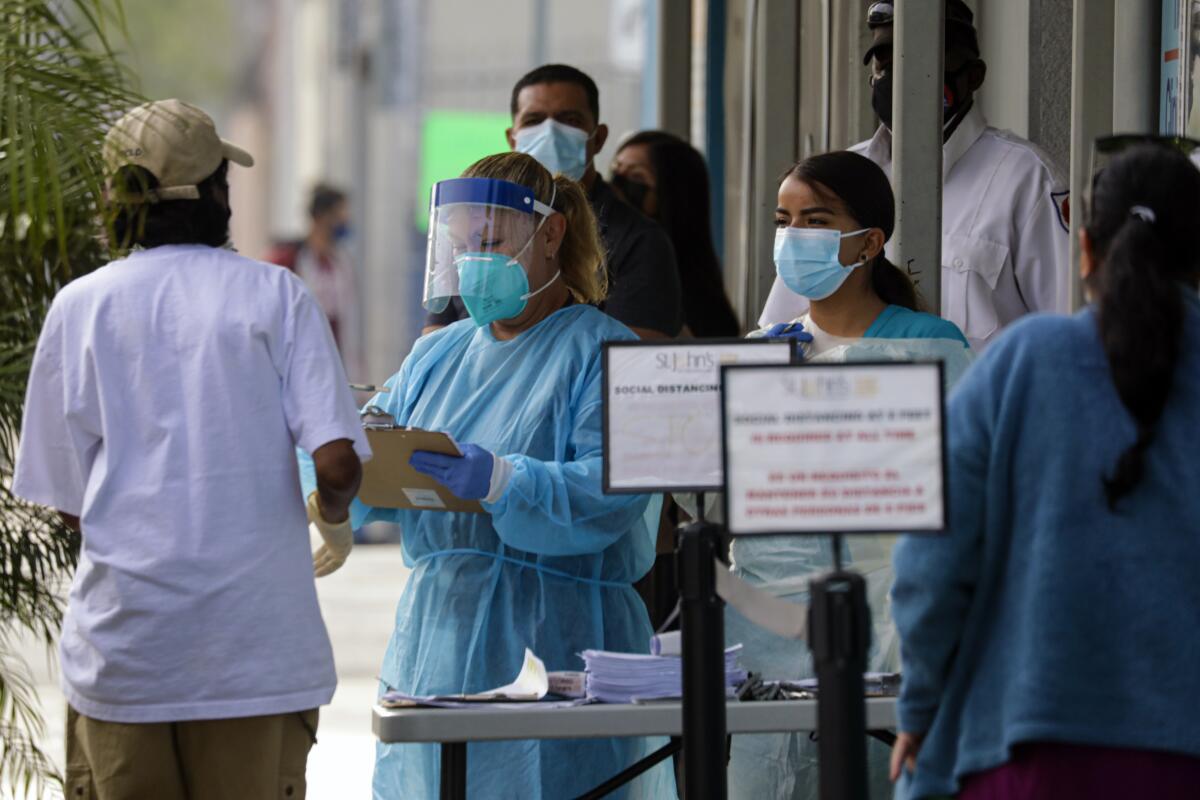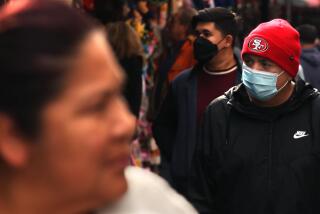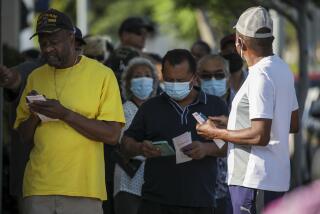California breaks coronavirus-related death record for fourth time this month

California has broken another record for the number of coronavirus-related deaths in a single day, cataloging at least 189 deaths Wednesday, according to a Los Angeles Times count of California’s 58 counties.
It was the second consecutive day — and the fourth time this month — that the state has broken its single-day death record; on Tuesday, 174 deaths were recorded.
The rising death toll comes more than a month into a surge of new COVID-19 cases that came with the reopening of the economy. Just before the Fourth of July weekend, officials imposed new restrictions with hopes of slowing the spread of infections.
California has now recorded nearly 9,000 deaths since the pandemic began. Although it is often noted that the state has seen far fewer fatalities than New York — where 32,653 people have died — other nations have endured far smaller death tolls than California.
The cumulative coronavirus-related death toll is about 1,000 in Japan, 300 in South Korea, 176 in Australia, 22 in New Zealand and 7 in Taiwan. Japan and South Korea each have populations greater than that of California.
Countries that have done a much better job of slowing infections have done so through the widespread wearing of masks, quarantining of travelers, aggressive testing and contact tracing, isolating the sick and strict safety protocols.
In countries such as New Zealand, the pandemic control strategy never became politicized, unlike in California, where a number of people are vociferously opposed to wearing masks.
“Everybody was united in the message, and they did it, they took care of it. And really controlled the outbreak in their country,” said Dr. Otto Yang, professor of medicine and associate chief of infectious diseases at the David Geffen School of Medicine at UCLA.
At least 12,285 new coronavirus cases in California were reported Wednesday, a new single-day record for cases. The last time the daily case record was broken was July 22, when 12,062 cases were recorded. Wednesday also marked Los Angeles County’s worst single-day tally of coronavirus cases and deaths, although that count was partly a result of a backlog in data reporting.
At least 91 deaths were reported in L.A. County on Wednesday, breaking a single-day record set May 19, when 84 deaths were recorded. L.A. County also reported at least 4,793 COVID-19 cases Wednesday, breaking the single-day record of July 16, when 4,506 cases were recorded.
L.A. County now has a cumulative coronavirus death toll of at least 4,518, more than half the state’s total of at least 8,912. There are at least 183,456 confirmed cases in L.A. County; statewide, the total is at 485,831 cases.
Across the U.S., more than 150,000 people have died of COVID-19, a death toll larger than that of any other nation.
By various measures, the coronavirus pandemic is now worse in many areas of California than it was in the week leading up to Memorial Day — some bleaker than others.
The San Joaquin Valley, an eight-county region of the Central Valley stretching from Stockton to Bakersfield, is one of the regions where pandemic conditions have deteriorated dramatically. In the weeklong period that ended on Memorial Day, 42 residents of the San Joaquin Valley died of the coronavirus; in the seven-day period that ended Monday, 105 residents had died.
Deaths are also on the upswing in the seven-county Sacramento region. Over the same time period, weekly deaths rose from 4 to 25.
The nine-county San Francisco Bay Area has seen its weekly death toll nearly triple in the same time period — from 20 to 57; San Diego County’s weekly death toll doubled over the same time period, from 28 to 55.
The five-county Southern California area — L.A., Orange, Riverside, San Bernardino and Ventura counties — has seen weekly deaths increase from 357 to 493 in that same time period, an increase of 38%.
There are some signs that California’s most recent surge — while still growing — has started to slow down. For the week that ended Tuesday, the state recorded an average of 9,157 new confirmed cases daily, a 2% increase from the previous week. That’s a much slower increase than what happened in the week that ended July 14, when the daily average of new cases was 8,902, a 20% jump from the previous week.
In addition, the rate at which coronavirus tests are coming back positive has been stable in recent weeks statewide. A Times analysis found that California’s seven-day coronavirus positive test rate has generally stayed between 7% and 8% since July 5. Also, the effective transmission rate of the coronavirus statewide is estimated to be 1.02 — meaning every infected person, on average, transmits the virus to 1.02 other people.
But looking at the average conceals the deep problems in harder-hit areas of California.
In the San Joaquin Valley, the transmission rate of the virus is as high as 1.4, Dr. Mark Ghaly, secretary of the California Health and Human Services Agency, said this week at a media briefing in Stockton, “which tells us we have a great deal of work to do to get transmission rates down here in the Central Valley.”
In some hospitals in the Central Valley, 65% of regular beds are filled with COVID-19 patients, Ghaly said. Federal medical teams have been dispatched to hospitals in the Central Valley and Southern California.
In the Central Valley, “you’re not anywhere close to being under control there,” said Dr. Kirsten Bibbins-Domingo, chair of UC San Francisco’s Department of Epidemiology and Biostatistics. “When we think of a state, our average numbers look better, but we cannot forget that in the middle of the state, the numbers look worse.”
The same problem can occur on the county level, where a county overall might look good, “but there are communities that still have high rates of transmission,” Bibbins-Domingo said.
“And unless we focus our attention on the areas where there is high rates of transmission, we are not going to get either the county or the state under control,” Bibbins-Domingo said. “And that’s one of the fallacies in California just constantly looking at the average effects, whether it’s statewide or within a county.”
Times staff writers Priya Krishnakumar and Andrea Roberson contributed to this report.
More to Read
Sign up for Essential California
The most important California stories and recommendations in your inbox every morning.
You may occasionally receive promotional content from the Los Angeles Times.













